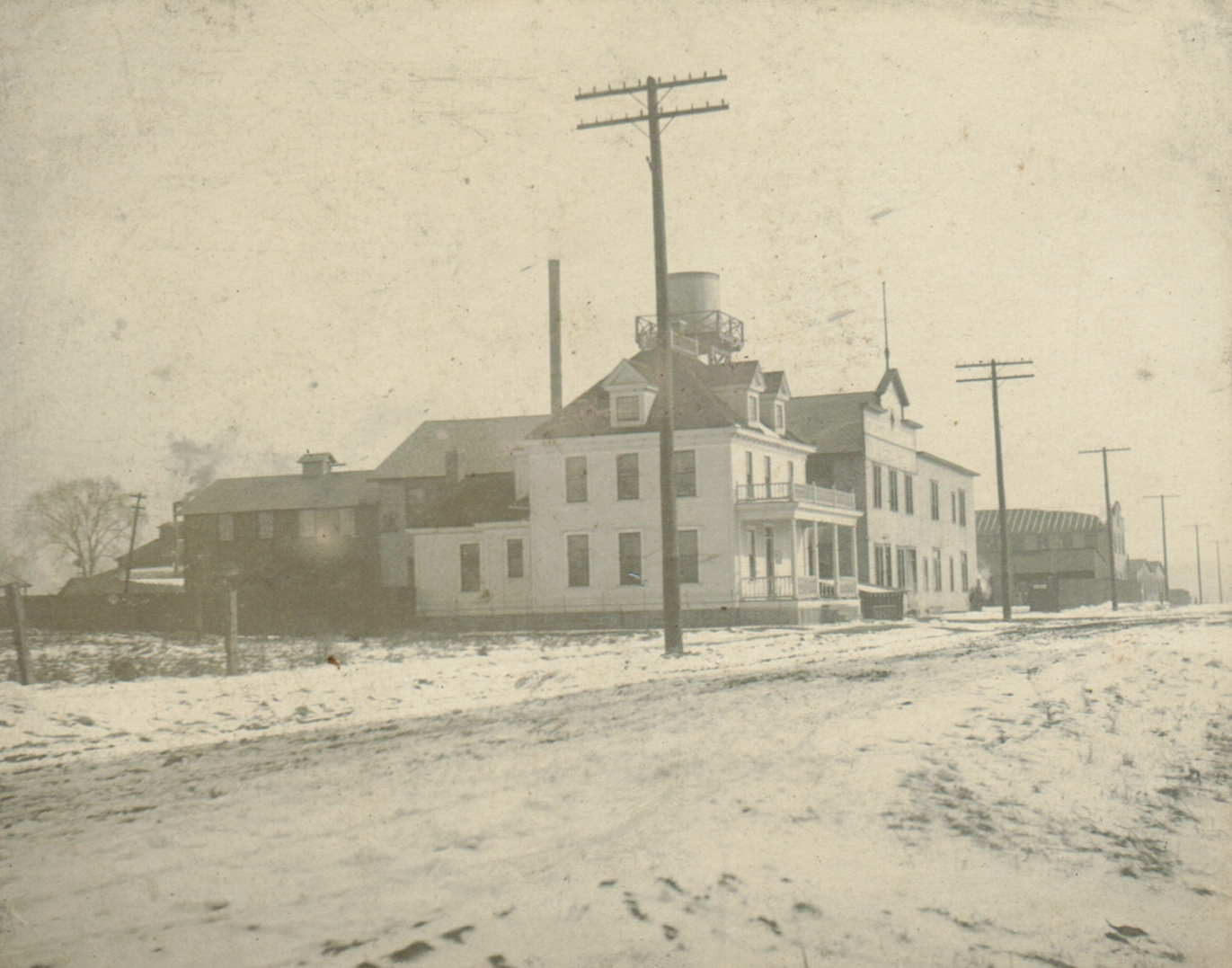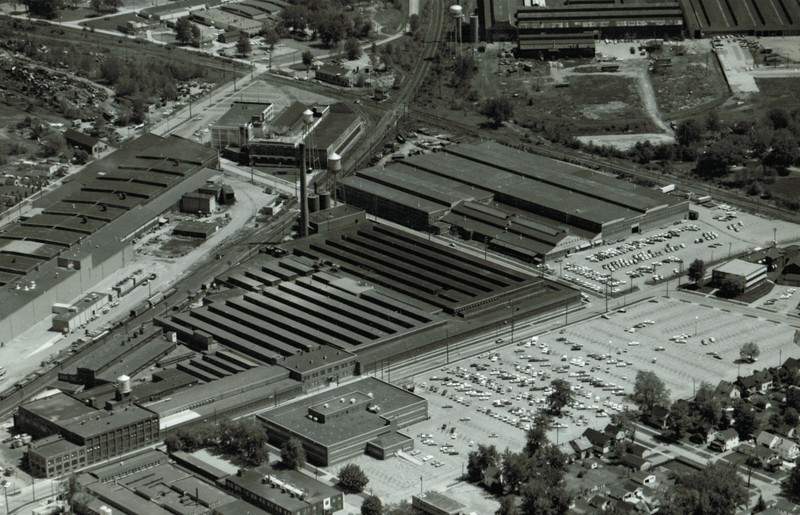Packard Electric
Introduction
Text-to-speech Audio
Images
Packard Electric 1893 (Courtesy of The National Packard Museum collection)
.jpg)
Packard Electric ca. 1900 (Courtesy of The National Packard Museum collection)

Packard Electric ca. 1960 (Courtesy of The National Packard Museum collection)

Ariel of Dana Street (Courtesy of The National Packard Museum collection)

(Courtesy of The National Packard Museum collection)

Backstory and Context
Text-to-speech Audio
In 1801, the Packard family settled in Austintown, approximately 12 miles away from Warren, where Packard Electric will eventually be formed. Thomas Packard was part of the Youngstown Civil District, and had part in creating the Warren-Ashtabula Turnpike, which survives today as Mahoning Avenue in Warren. Thomas's son William was born in Austintown in 1803. William later moved to Lordstown and became the first Postmaster in the area. Around this time, the gold rush in California was in full force, and he left in 1849 to find his own fortune. Throughout this journey, he sent many letters back to his 9 adult children and wife, but they never made it to Ohio. His family assumed he was dead, but they did receive a letter in 1865 from William stating that was in fact alive and well. Although his sons did visit him, he died before he was able to make it back to Ohio.
One of William's sons, Warren, was born in 1828 in Lordstown. He was a very successful entrepreneur and owned a booming hardware store. He married Mary Doud and had two sons William Doud and James Ward, and three daughters, Alaska, Carlotta, and Cornelia Olive. Alaska is of particular note, as she is considered the first female FBI field agent. She served from 1922 to 1924 during the Mann Act. In 1924, J. Edgar Hoover became the head of the FBI and the three female agents were asked to resign. The first female agent after this incident was not hired until 1972.
Both William and James attended Warren city public schools and went on to college. William went to Ohio State University for only one year before returning home and working for his father. Because he worked so closely with the family business, he quickly learned how to run a successful business. In 1886, he moved to New York City where he worked for the Sawyer-Mann Company, an incandescent lamp manufacturer.
James studied engineering at Lehigh University in Pennsylvania. He graduated in 1884 with a mechanical engineering degree, and took a job with Sawyer-Mann with his brother. During his time at Sawyer-Mann, he earned the first two of his many patents. In 1890, both brothers decided to take their experience back to Warren Ohio and founded the Packard Electric Company.
The building was built on North Avenue in Warren, and its main purpose was to produce electric lamps. It started off small with only 10 employees. James focused on developing better incandescent light bulbs, creating longer lasting bulbs. The subsidiary New York & Ohio Company, located on North Street, produced these bulbs. In 1896, the Packard Electric Company expanded and installed an electrical transformer production lines.
In 1898, James purchased a Winton automobile in Cleveland Ohio. On their way back to Warren, the car broke down due to an electrical failure. Frustrated, James and William decided to build their own car. The first Packard automobile was built in the corner of the New York & Ohio lamp plant and was driven through the streets of Warren on November 6, 1899. When their cars were featured at the first national Automobile Show in New York, William D. Rockefeller bought two.
The development of the Packard Lac-Kard Cable was a game changer. In pre-Packard cars, there were issues with ozone gas emitting from cables when electricity was fed through them. This would lead to deterioration of the rubber insulation on spark plugs, and the wires would then arc. The Lac-Kard Cable used a lacquer coating to seal the cable from the ozone gas. These cables became the industry standard. The success of the Lac-Kard Cable pushed Packard Electric to be a lead automotive supplier. The brothers sold the lamp division to what would eventually be known as General Electric in 1903.
The innovation did not stop there. Packard Electric also created an acid proof cable in 1909 and a lower grade cable in 1913 that was more cost efficient. During World War I, Packard was a major supplier of wiring for aircraft. In 1917, Packard Electric produced armored cable that had thick steel sheathing that would protect the wiring from harsh environments. Even after World War I and into World War II, they continued to be innovative and expand their production facilities. At this point, Packard Electric was a division of General Motors, but they were still manufacturing in Warren Ohio. In 1964, Packard Electric opened the Engineering and Research Center to continue being on the forefront of innovation. By 1990, they had plants both across the United States and internationally.
The 100 year anniversary of Packard Electric was celebrated with the opening of the National Packard Museum. Packard Electric continued to expand, eventually creating a joint venture with China. The facility produced wiring for Audi and Volkswagen as well as Mitsubishi and Fuji Heavy Industry. In 1991, Packard operated as a division within General Motors that eventually became known as Delphi Automotive Systems. Because of this the name was changed from Packard Electric to Delphi Packard Electric Systems. They eventually dropped the name Packard, and is publicly known as Delphi. In 1999, Delphi Automotive Systems left General Motors and became their own entity.
Cite This Entry
Annie Talmadge on behalf of Ohio History Service Corps . "Packard Electric ." Clio: Your Guide to History. March 1, 2021. Accessed April 14, 2025. https://theclio.com/entry/126628
Sources
The National Packard Museum . Packard Timeline. Accessed February 24th 2021. http://packardtimeline.com/.
Mines, Cindee. Packard, Alaska (1868-1934), Trumbull County Historical Society . Accessed February 12th 2021. https://trumbullcountyhistory.com/packard-alaska/.
Moell, Sarah. Packard Electric, Trumbull County Historical Society . Accessed February 24th 2021. https://trumbullcountyhistory.com/packard-electric/.

